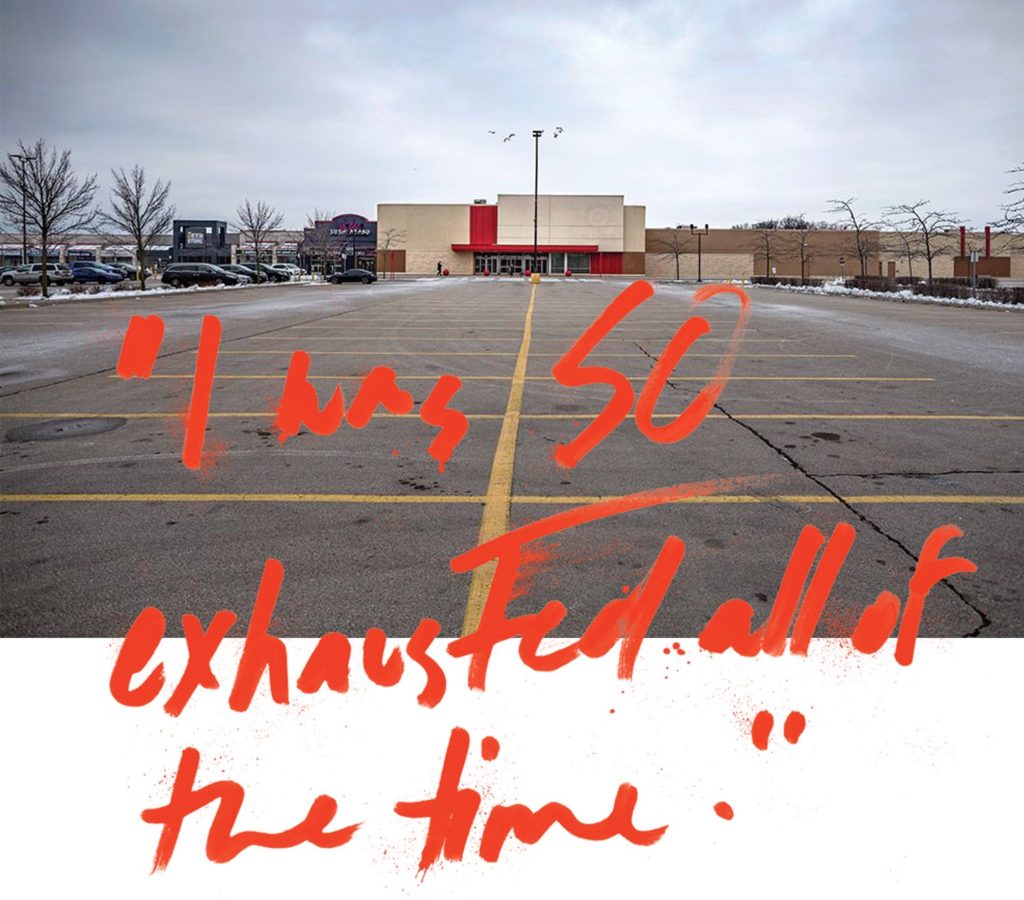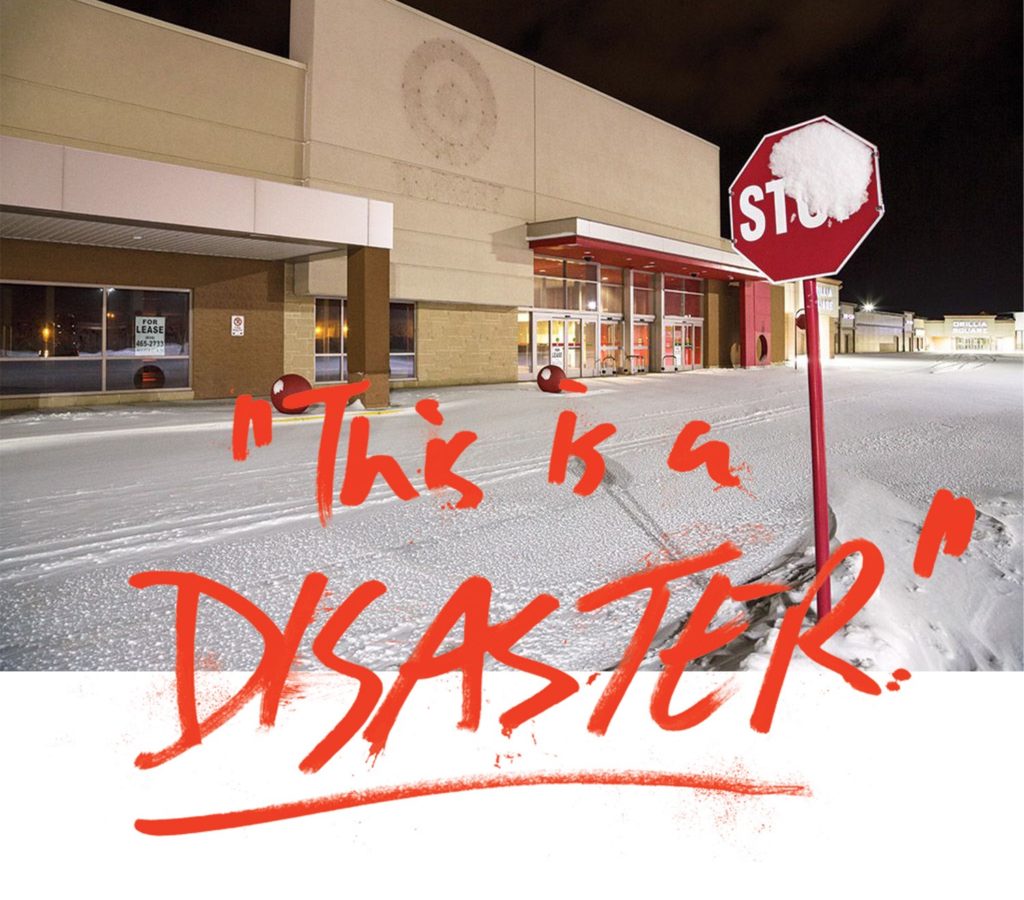The grand opening of Target Canada was set to begin in one month, and Tony Fisher needed to know whether the company was actually ready.
In February 2013, about a dozen senior-level employees gathered at the company’s Mississauga, Ont., headquarters to offer updates on the state of their departments. Fisher, Target Canada’s president, was holding these meetings every day as the launch date crept closer. The news was rarely good. The company was having trouble moving products from its cavernous distribution centres and onto store shelves, which would leave Target outlets poorly stocked. The checkout system was glitchy and didn’t process transactions properly.
Worse, the technology governing inventory and sales was new to the organization; no one seemed to fully understand how it all worked. The 750 employees at the Mississauga head office had worked furiously for a year to get up and running, and nerves were beginning to fray. Three test stores were slated to open at the beginning of March, followed shortly by another 21. A decision had to be made.
Fisher, 38 years old at the time, was regarded as a wunderkind who had quickly risen through the ranks at Target’s American command post in Minneapolis, from a lowly business analyst to leader of a team of 400 people across multiple divisions. Launching the Target brand in a new country was his biggest task to date.
The news he received from his group that February afternoon should have been worrying, but if he was unnerved, Fisher didn’t let on. He listened patiently as two people in the room strongly expressed reticence about opening stores on the existing timetable. Their concern was that with severe supply chain problems and stores facing the prospect of patchy or empty shelves, Target would blow its first date with Canadian consumers. Still, neither one outright advocated that the company push back its plans.
“Nobody wanted to be the one to say, ‘This is a disaster,’” says a former employee.
But by highlighting the risks of opening now, the senior employees’ hope was that Fisher would tell his boss back in Minneapolis, Target CEO Gregg Steinhafel, that they needed more time.
The magnitude of what was at stake began weighing on some of those senior officials.
“I remember wanting to vomit,” recalls one participant.
Nobody disagreed with the negative assessment—everyone was well aware of Target’s operational problems—but there was still a strong sense of optimism among the leaders, many of whom were U.S. expats. The mentality, according to one former employee, was, “If there’s any team in retail that can turn this thing around, it’s us.”
The group was riding a wave of momentum, in fact. They had overcome seemingly endless hurdles and worked gruelling hours to get to this point, and they knew there were costs to delaying. The former employee says the meeting ultimately concerned much more than when to open the first few stores; it was about the entirety of Target’s Canadian launch. Postponement would mean pushing back even more store openings. Everyone else in attendance expressed confidence in sticking to the schedule, and by the time the meeting concluded, it was clear the doors would open as promised.
“That was the biggest mistake we could have made,” says the former employee.
Roughly two years from that date, Target Canada filed for creditor protection, marking the end of its first international foray and one of the most confounding sagas in Canadian corporate history. The debacle cost the parent company billions of dollars, sullied its reputation and put roughly 17,600 people out of work.
Target’s arrival was highly anticipated by consumers and feared by rival retailers. The chain, whose roots stretch back to 1902, had perfected its retail strategy and grown into a US$70-billion titan in its home country. Target was a careful, analytical and efficient organization with a highly admired corporate culture.
The corporation’s entry into Canada was uncharacteristically bold—not just for Target, but for any retailer. Under Steinhafel, the company paid $1.8 billion for the leases to the entire Zellers chain in 2011 and formulated a plan to open 124 locations by the end of 2013. Not only that, but the chain expected to be profitable within its first year of operations.
Why Target Canada collapsed has been endlessly dissected by analysts, pundits and journalists. But the people who know what happened best are the employees who lived through the experience. On the first anniversary of the company’s bankruptcy filing, Canadian Business spoke to close to 30 former employees in Canada and the U.S. to find out how Target, one of the best retailers in North America, got it so wrong in Canada.
(Target declined to comment on specific issues, pointing to previous statements it has made on its Canadian venture. The former employees interviewed for this story requested anonymity to preserve relationships in the industry.)
Even those employees remain baffled by how Target Canada collapsed. But what emerged is a story of a company trapped by an overly ambitious launch schedule, an inexperienced leadership team expected to deal with the biggest crisis in the firm’s history, and a sophisticated retail giant felled by the most mundane, basic and embarrassing of errors.

In the fall of 2013, hundreds of Target Canada head office staff piled into the auditorium at the Mississauga Living Arts Centre for a state-of-the-union address from their leaders. The employees were weary and frustrated by this point. The bulk of the 124 stores had opened, and it was clear the launch had gone seriously awry. Consumers were frustrated when confronted with empty shelves, and the media and financial analysts were hammering the company for it.
On stage, Fisher stated his conviction that Target Canada was making progress and that 2014 would be a greatly improved year. A Q&A session followed; one employee bravely asked Fisher what he would do differently if he could do the launch over again. A man in the front row stood up and offered to field the question. Taking the microphone, Steinhafel, Target’s CEO, didn’t hesitate with his answer: He would renegotiate the real estate deal that facilitated the company coming to Canada in the first place.
That deal started with Richard Baker, the executive chairman of Hudson’s Bay Co. Although Baker is a retail executive, he is, at heart, a real estate man. His maternal grandfather started buying and selling real estate in New York City in 1932 and helped pioneer the concept of shopping malls. Baker’s greatest business insight was to recognize the value of the property developed by both his grandfather and father.
In the 1990s, he started selling some of it off to various companies, including Walmart. That relationship proved fortuitous in late 2010, when Walmart approached him and offered to buy the Zellers chain from HBC. Baker realized there was more value to Zellers’ real estate than to the operation itself, since Walmart had soundly beaten the brand. An astute deal maker, Baker and his team reached out to Target to stoke the company’s interest. (Baker, through a spokesperson, declined to comment.)
It was an open secret that Target was interested in the Canadian market. But the company had previously decided it wanted to grow as quickly as possible if it were to enter Canada, rather than pursue a slow, piecemeal expansion. The challenge was in acquiring enough real estate to make that possible. The Zellers sale provided just such an opportunity. After Baker’s team let Target know Zellers was on the block—and Walmart was interested—the American company acted quickly to finalize its own offer.
Walmart would eventually back out, but Target put down $1.8 billion. Steinhafel bought everything, essentially committing the company to opening stores as quickly as possible to avoid paying rent on stores that weren’t operational and leaving landlords without anchor tenants. The price Steinhafel paid raised eyebrows.
“When the numbers got up as high as they did, we found that pretty surprising,” says Mark Foote, the CEO of Zellers at the time.
But Steinhafel may have felt justified in making such a bold move. In the three years since he was appointed CEO, he’d boosted revenue 8.3%—not a huge number, but an impressive one, considering the U.S. was experiencing the worst recession since the Great Depression.
Steinhafel had joined Target in 1979, and his entire professional career had been spent with the company. Target experienced steady growth during that time, and Steinhafel had simply become accustomed to succeeding.
“The company had never really failed before,” says a former employee who worked in both the U.S. and Canada.
There was no reason to think Target wouldn’t be able to pull this off.
Almost immediately, employees in Minneapolis were seconded to work on the Canadian launch. It was considered a privilege to be recruited.
“The company was pouring in resources left, right and sideways, so it was palpably exciting in Minneapolis,” says a former employee.
But there was also immense pressure.
“From the very beginning, there was a clock that was ticking,” says the former employee. “And that clock was absurd.”
The company did everything it could to remove barriers that might slow progress and to ensure decisions could be made quickly. Timelines were hugely compressed. Building a new distribution centre from scratch, for example, might take a few years. Target was going to do it in less than two years—and it planned to construct three of them.
One of the most important decisions concerned technology—the systems that allow the company to order products from vendors, process goods through warehouses and get them onto store shelves promptly. In the U.S., Target used custom technology that had been fine-tuned over the years to meet its exacting needs, and the corporation had developed a deep well of knowledge around how these systems functioned.
Target faced a choice: Was it better to extend that existing technology to Canada or buy a completely new, off-the-shelf system?
Finding an answer was tricky. By using Target’s existing technology, employees in Canada could draw on the large amount of expertise in the U.S. That plan had shortcomings as well. The technology was not set up to deal with a foreign country, and it would have to be customized to take into account the Canadian dollar and even French-language characters.
Those changes would take time—which Target did not have. A ready-made solution could be implemented faster, even if the company had little expertise in actually using it.
The team responsible for the decision went with a system known as SAP, made by the German enterprise software company of the same name. Considered the gold standard in retail, SAP is used by many companies around the world, from Indigo in Canada to Denmark’s Dansk supermarket chain. It essentially serves as a retailer’s brain, storing huge amounts of data related to every single product in stores.
That data would be fed by SAP into Target’s other crucial systems: software to forecast demand for products and replenish stocks, and a separate program for managing the distribution centres. After implementing SAP in Canada, Target wanted to eventually switch the U.S. operations over as well, aligning the two countries and ensuring the entire company benefited from the latest technology.
While SAP might be considered best in class, it’s an ornery, unforgiving beast. Sobeys introduced a version of SAP in 1996 and abandoned the effort by 2000. (It wasn’t until 2004 that the grocery chain tried again.) Similarly, Loblaws started moving to SAP in 2007 and projected three to five years to get it done. The implementation took two years longer than expected because of unreliable data in the system.
Target was again seeking to do the impossible: It was going to set up and run SAP in roughly two years. The company wasn’t doing it alone, however, and hired Accenture (which also worked on Loblaws’ integration) as the lead consultant on the project.
Target believed the problems other retailers faced were due to errors in data conversion. Those companies were essentially taking information from their existing systems and translating it for SAP, a messy process in which it’s easy to make mistakes. Target, on the other hand, was starting fresh. There was no data to convert, only new information to input.
By early 2012, with the planned opening still a year away, the nerve centre for the Canadian launch had moved from Minneapolis to Mississauga, and waves of American expats settled up north. Hiring was a top priority.
Target has a unique, well-established corporate culture in the U.S., which the company views as one of the reasons for its success, and leaders sought to replicate that environment here. Target describes itself as “fast, fun and friendly,” to work for and it’s a place where attitude and soft skills are of equal—if not more—importance to experience.
“Target’s motto was they could train you for the job, but they couldn’t train culture,” says a former employee.
In the U.S., the company prides itself on its development programs for even junior positions like business analysts, who help co-ordinate the flow of product, and merchandising assistants, who work with buyers to choose which products to stock and negotiate costs with vendors.
Target typically recruits candidates for these positions straight out of school and prepares them for a career in retail. That’s how Tony Fisher got his start—he joined the company as an analyst in 1999, after he was drafted by the Texas Rangers baseball organization and played for two years in the minor leagues. Young employees receive months of instruction and are paired with a mentor. Hiring for culture over experience works, essentially, because Target in the U.S. provides ample training.
In Canada, the company succeeded in hiring people with the right personalities, but young staff received only a few weeks of training, according to former employees who worked at Target in both countries. The Canadian team lacked the institutional knowledge and time to properly mentor the new hires.
“Everyone was stretched thin. We didn’t have the manpower to get everything done in the time frame that was laid out,” says a former employee.
Another was surprised to see how green his colleagues were.
“I was one of the older people there, and I was in my mid-30s,” he says.
Target Canada would eventually learn what happens when inexperienced employees working under a tight timeline are expected to launch a retailer using technology that nobody—not even at the U.S. headquarters—really understood.

Strange things started happening in 2012, once ordering began for the pending launch. Items with long lead times coming from overseas were stalled—products weren’t fitting into shipping containers as expected, or tariff codes were missing or incomplete. Merchandise that made it to a distribution centre couldn’t be processed for shipping to a store. Other items weren’t able to fit properly onto store shelves. What appeared to be isolated fires quickly became a raging inferno threatening to destroy the company’s supply chain.
A team assigned to investigate the problem discovered an astounding number of errors. Product dimensions would be in inches, not centimetres or entered in the wrong order: width by height by length, instead of, say, length by width by height. Sometimes the wrong currency was used. Item descriptions were vague. Important information was missing. There were myriad typos. “You name it, it was wrong,” says a former employee. “It was a disaster.”
It was also something the company should have seen coming. The rush to launch meant merchandisers were under pressure to enter information for roughly 75,000 different products into SAP according to a rigid implementation schedule. Getting the details from suppliers largely fell on the young merchandising assistants.
In the industry, information from vendors is notoriously unreliable, but merchandising assistants were often not experienced enough to challenge vendors on the accuracy of the product information they provided. (The staff were also working against the countdown to opening.)
“There was never any talk about accuracy,” says a former employee. “You had these people we hired, straight out of school, pressured to do this insane amount of data entry, and nobody told them it had to be right.”
Worse, the company hadn’t built a safety net into SAP at this point; the system couldn’t notify users about data entry errors. The investigative team estimated information in the system was accurate about 30% of the time. In the U.S., it’s between 98% and 99%.
(Accenture, which Target hired as a consultant on SAP, said in a statement: “Accenture completed a successful SAP implementation for Target in Canada. The project was reviewed independently and such review concluded that there is no Accenture connection with the issues you refer to.”)
The investigating team went to Fisher and John Morioka, the senior vice-president of merchandising, with a drastic proposal: Shut down the entire merchandising division so everyone could comb through and verify every single piece of data in the system—manually.
The team stressed there was simply no other way to get it done. Hiring an external consultant would take too long, and it was impossible to expect the employees to do such a painstaking, arduous task and their regular jobs at the same time. Fisher immediately gave the green light.
Thus, “data week” was held in the fall of 2012. Merchandisers essentially had to confirm every data point for every product with their vendors. A buyer might have 1,500 products and 50 to 80 fields to check for each one. The more experienced employees had the foresight to keep records of verified information (dubbed “sources of truth”), which made the task a little easier. Others weren’t so lucky.
Complicating matters was the dummy information entered into the system when SAP was set up. That dummy data was still there, confusing the system, and it had to be expunged.
“We actually sat there and went through every line of data manually,” says a former employee. “It was terrible.”
Target anticipated how awful it would be and designed the week to help keep employees sane. To kick it off and rally spirits, a few employees performed a hip-hop song-and-dance routine on the first day. Ice cream and pizza flooded in to keep employees fuelled up, some of whom stayed well past midnight that week, squinting at screens through bleary eyes.
There was an entirely different process to ensure the correct data actually made it into SAP. The employees in Mississauga couldn’t do so directly. Instead, the information was sent to a Target office in India, where staff would load it into SAP. Extra contractors had to be hired in India, too.
“Sometimes even when we had the data correct, it got mixed up by the contractors in Target India,” says a former employee.
(Another former employee disputes this: “Sometimes the quality of their work wasn’t so great, but for the most part they did a good job.”)
In any event, uploading took longer than expected, and data week stretched into two. Periodic data blitzes in individual departments became common into the following year.
But data week was successful on a number of fronts. It weeded out the worst of the errors and forced Target Canada to realize the importance of accurate data. It was also a bonding experience—as terrible as it was.
“The company came together that week,” says a former employee. “We were all in the trenches doing this unglamorous work.”

On March 4, 2013, Tony Fisher led a gaggle of reporters through a new Target location in Guelph, Ont. The store officially opened the next day, along with two others in the province.
The company had been teasing consumers for a year at this point, starting with a pop-up shop in Toronto featuring designer Jason Wu. There had also been a high-profile ad during the Academy Awards to hype the Canadian launch, and actors Sarah Jessica Parker and Blake Lively were lined up to appear at the grand opening.
Workers were still stocking shelves at the time, and signs throughout the store read, “We’re open (mostly).” The three Ontario stores were part of Target’s soft launch, and the company explained in a press release that the goal was to use them to iron out kinks and “determine operational readiness” before opening 21 more locations as part of its official launch that month.
At the Guelph store, Fisher, wearing a red checkered shirt and a red tie, pointed out the bright lighting and wide aisles, and promised a quick, convenient checkout experience.
“Not only have we brought that same Target brand experience,” he said, referring to the U.S., “but we’ve actually enhanced it and made it better.”
Fisher sported a head of thick dark hair and could flash a camera-ready smile when he needed to. Some of his former employees dismiss him as just a media-friendly face, but others describe him as whip-smart, detail oriented and incredibly dedicated to Target. More than a few people say Fisher “bled Target red.”
When he wasn’t talking to reporters about the pending launch, he could have a stern, imposing demeanour (a defence mechanism to compensate for his young age, perhaps), so much so that employees would warn prospective hires about to interview with him not to be put off. It wasn’t until Fisher got to know people that he warmed up.
His tour of the first store was breathlessly covered by media, and consumer anticipation was running high. In Guelph, customers lined up before the store opened at 8 a.m., and when they were finally let in, floor staff cheered and offered them high-fives. News crews were ready to snag customers as they left and cajole them into showing off their purchases. (The first items bought at Target Canada? A Tarzan DVD and a Michael Bolton CD.)
The foot traffic in the early days was more than expected, which was encouraging, but it didn’t take long for consumers to start complaining on social media about empty shelves.
Related: How brands can stay relevant on social media
“Target in Guelph, please stock up and fill the shelves,” wrote one aggrieved shopper on Facebook. “How can I or anyone purchase if there is nothing left for me to buy?”
Target told the media that it was overwhelmed by demand and made assurances that it was improving the accuracy of product deliveries. The reality was that Target was still struggling with data quality problems that were hampering the supply chain, and it didn’t have time to address the root causes before opening another wave of stores.
Problems multiplied, and the public mood continued to turn against Target. Consumers soured on the brand when confronted with empty shelves—the exact scenario some senior employees warned of earlier in the year.
Ironically, even as consumers encountered barely stocked stores, Target’s distribution centres were bursting with products. Target Canada had ordered way more stock than it could actually sell. The company had purchased a sophisticated forecasting and replenishment system made by a firm called JDA Software, but it wasn’t particularly useful at the outset, requiring years of historical data to actually provide meaningful sales forecasts. When the buying team was preparing for store openings, it instead relied on wildly optimistic projections developed at U.S. headquarters.
According to someone with knowledge of the forecasting process in Minneapolis, the company treated Canadian locations the same way they did operational stores in the U.S. and not as newcomers that would have to draw competitors away from rival retailers. Even if the stores were in out-of-the-way spots—and some of the locations in the Zellers portfolio certainly were—the company assumed the strength of the Target brand would lure customers. There was another element at play, too.
“Once you signed up to do 124 Zellers locations, it felt like there was a point where it’s like we have to assume sales will be good,” says the former employee. “It’s very backwards.”
In Canada, some buyers also relied on vendors for guidance, but vendors fell under the Target spell like everyone else.
“They would say, ‘Because it’s Target, they’ll sell double what Zellers was selling.’ And that would be what we put in that initial forecast,” says a former buyer.
In consequence, Target ordered too much product that first year. It all hit the distribution centres at the same time, creating a severe bottleneck.
The depots were hampered by other factors, caused by lingering data problems and the learning curve associated with the new systems. Manhattan, the company’s warehouse software, and SAP weren’t communicating properly.
Sometimes, the issues concerned dimensions and quantities. An employee at headquarters might have ordered 1,000 toothbrushes and mistakenly entered into SAP that the shipment would arrive in a case pack containing 10 boxes of 100 toothbrushes each. But the shipment might actually be configured differently—four larger boxes of 250 toothbrushes, for example. As a result, that shipment wouldn’t exist within the distribution centre’s software and couldn’t be processed. It would get set aside in what was designated as the “problem area.”
These sorts of hang-ups happen at any warehouse, but at Target Canada, they happened with alarming frequency. Warehouse workers got so desperate to move shipments they would sometimes slice open a crate that was supposed to contain, say, a dozen boxes of paper towels but only had 10, stuff in two more boxes, tape it shut and send it to a store that way.

By fall of 2013, Target’s three distribution centres—approximately four million square feet in all—were overflowing with goods. Tractor-trailers sat idling in the yards, waiting to be unloaded. The situation got so bad that Target scrambled to rent a handful of storage facilities to accommodate all of the inventory flooding in. The process of determining which goods to send to these rented facilities was haphazard, making it difficult to track things down later.
“It was like a massive black hole,” says a former employee.
Another recalls feeling shocked when visiting the rental warehouse in Vancouver.
“It was the most rickety, Podunk thing you can imagine,” says the former employee, likening it to the treacherous labyrinthine underworld in Indiana Jones and the Temple of Doom.
American expats, accustomed to the efficiency of the U.S. operations, were flabbergasted. Waves of senior staff were flown in from Minneapolis, but because they were unfamiliar with the technology Target Canada used, there wasn’t much they could do.
The issues at the distribution centres caused havoc downstream. Stores might end up with an abundance of some products and a dearth of others. The auto-replenishment system, which keeps track of what a store has in stock, wasn’t functioning properly, either.
Like many other parts of retail, replenishment is an exacting science that can go haywire without correct data. At Target Canada, the technology relied on having the exact dimensions of every product and every shelf in order to calculate whether employees need to pull more products to fill an empty rack. Much of that data was still incorrect, and therefore the system couldn’t be relied upon to make accurate calculations.
The problem became immediately apparent when Target opened its first three test stores. Fisher made the call to shut off the system and replenish manually. That meant store employees had to literally walk the floor and check each shelf—a laborious, error-laden process. (Auto-replenishment wasn’t switched back on until later that year.)
The Mississauga head office, meanwhile, didn’t have a clear picture of how bad the situation was inside stores. The merchandising department’s software often indicated items were in stock, but then the team would field confused and angry phone calls from employees responsible for store operations, demanding to know why they didn’t have products.
“We almost didn’t see what the customer was seeing,” says a former employee. “We’d look on paper and think we’re OK. Then we’d go to the store, and it’s like, ‘Oh my God.’”
To add even more headaches, the point-of-sale system was malfunctioning. The self-checkouts gave incorrect change. The cash terminals took unusually long to boot up and sometimes froze. Items wouldn’t scan, or the POS returned the incorrect price. Sometimes a transaction would appear to complete, and the customer would leave the store—but the payment never actually went through.
The POS package was purchased from an Israeli company called Retalix, which worked closely with Target Canada to address the issues. Progress was maddeningly slow.
In 2014, a Retalix team flew to Toronto to see first-hand what Target was dealing with. After touring a store, one of the Retalix executives remarked, “I don’t understand how you’re using this,” apparently baffled the retailer managed to keep going with so many bugs.
But Target didn’t have time to find a new vendor and deploy another technology.
“We were bound to this one bad decision,” says a former employee.
(Retalix was purchased in 2012 by NCR Corp., the American global payment transaction firm.)
“When entering a new country, it is normal for retail software systems to require updates to tailor the solution to market needs and processes,” NCR said in a statement in response to questions about Target’s experience. “NCR was making progress to customize the solution for the market and Target’s new operations until their decision to exit the country.”
Unlike SAP, Retalix is not an industry standard, and why Target chose it isn’t entirely clear. Former employees suggest that Retalix sold itself on its omnichannel capabilities, meaning it would be able to process payments on mobile devices. Time may have been another factor.
“In the U.S., this never would have made it off the launching pad,” says a former employee. “There would have been a robust process for testing.”
Meanwhile, after a few rounds of store openings, the status update meetings Fisher held at headquarters had turned darkly comic. After the regular rundown of crippling operational problems, the president still ended each gathering with a pep talk of sorts, reiterating how proud he was of the team and all they had accomplished.
Despite his stubborn optimism, those meetings had grown more tense too. Everyone knew the launch was a disaster and the company had to stop opening stores so it could fix its operational problems, but no one actually said so.
“Nobody wanted to be the one person who stopped the Canadian venture,” says a former employee. “It wound up just being a constant elephant in the room.”
There was also a sense of powerlessness. The Canadian expansion was ultimately driven by Minneapolis, and because of the real estate deal hatched by CEO Gregg Steinhafel, the company was committed to opening these stores. Speaking up wouldn’t have changed much.
“That’s why, in the end, nobody fell on a sword. Because of the leases, it had to move forward.”
Tony Fisher felt it, too. He was open about telling employees that he’d never managed through such a challenging situation before. Former employees say his background—primarily in merchandising—was ill-suited to helping him deal with the severe operational and technological problems Target Canada faced.
Those close to Fisher say he took the company’s troubles personally. In the early days, he was a constant sight on the floor of Target Canada’s open-concept office, chatting with employees at all levels. But he and some of his leadership team became less visible as problems mounted.
“For leaders who have experience with failure, that would be the last thing you do,” says a former employee. “You would be front and centre, give confidence and reinforce the direction. That didn’t happen.”
Others contend Fisher’s schedule didn’t allow him to be as visible. As the situation worsened, he was frequently in meetings, participating in conference calls, visiting stores or flying to Minneapolis. (Fisher declined to comment.)
In February 2014, Target headquarters released its annual results, revealing a US$941-million loss in Canada. The company attributed the shortfall to growing pains, expansion costs and—because of all that excess inventory sitting in warehouses—significant markdowns.
“As we enter 2014 with a much cleaner inventory position, the team’s number one operation focus is on in-stocks—ensuring we have the right quantity of each item in the right place at the right time,” Steinhafel said on the earnings call.
It was his last as Target CEO. A month prior, Target had disclosed a massive security breach in which hackers stole the personal information of 70 million customers in the U.S. Combined with the bleeding operations in Target Canada, Steinhafel’s position was untenable, and he stepped down in May. (He walked away with US$61 million in compensation.) Fisher—hand-picked by Steinhafel—left the company two weeks later.
By the end, Fisher was practically a ghost.
“He gave every last ounce of himself. He was just done. He had nothing left,” says a former employee.
His departure wasn’t surprising, but it was deeply felt.
“I loved Tony. He’s probably one of the smartest people I’ve met,” says someone who worked with him closely. “He absolutely took the fall for Target Canada.” The reality is the odds were stacked against him from the start, given the extremely tight timeline and the thin margin for error. “Everyone was trying to execute Gregg Steinhafel’s deal,” says a former employee, “and once one thing went wrong, it was an impossible achievement.”
But someone else now had to try.

It was Mark Schindele who took over as head of Target Canada. He was a 15-year company veteran and previously served as a senior vice-president of merchandising operations in Minneapolis. At one point, Target Canada had printed a weekly flyer in which nearly every single item featured on the front cover was out of stock, a situation that would have been unheard of in Minneapolis. When Schindele learned of it, according to a former employee, he remarked, “I can’t believe it’s as bad as it actually is.”
A new crop of senior leaders arrived from U.S. HQ with Schindele, replacing some of the exhausted execs who handled the launch. The biggest difference between the two groups was attitude: The new team had energy. Decisions were made faster as well. Under Fisher, the company had trouble making tough calls.
“We had so much faith we could solve any problem. If we just work a little harder, we’ll get to the resolution,” says a former employee. “But then the thing in front of you explodes.”
For example, inventory started piling up in Target’s distribution centres again in early 2014, and it became clear the company needed to rent additional storage sites. Discussions dragged on for months. The new leadership, however, quickly implemented a plan to rent more space.
Schindele brought increased focus to the company, too. He prioritized what he called “mom’s shopping list,” which consisted of basic household items such as toilet paper, toothpaste and detergent. Employees at all points along the supply chain were to ensure those items made it to stores and stayed in stock. Those particular products were important because Target Canada needed to change people’s shopping habits and lure them away from Shoppers Drug Mart and Loblaws. But it didn’t stand a chance if it couldn’t offer the basics that bring people back to stores.
Even so, the company planned to reduce its emphasis on groceries. Target used groceries as a traffic driver in the U.S. and attempted to replicate that strategy here, failing to fully realize how competitive the category is in Canada. To further differentiate from other retailers, Schindele wanted to promote apparel and accessories, emphasizing Target’s “cheap chic” image, in direct contrast to Walmart. A massive product revamp was planned for the fall.
Related: How Subway Canada is building back consumer trust
Discussion about marketing and when it was appropriate to invite the consumer back into the stores after making a terrible first impression intensified. Those conversations started when Fisher was still in place. Around Target’s first anniversary, the marketing team proposed an “apology” campaign of sorts—something to acknowledge that the company had learned a lot about Canadians during its year of operation, and that it was seeking to improve the shopping experience. Fisher was not in favour of the idea, according to two former employees.
“Tony wouldn’t allow the marketing team to say to the Canadian public that we made a mistake,” says one. “I was in a meeting where he said, ‘That’s not who we are.’”
Another former employee suggests the reluctance wasn’t Fisher’s alone; all public relations decisions had to be vetted by headquarters in the U.S. at the time. Regardless, the idea was only hatched very shortly before Fisher left the company.
In June 2014, however, Target Canada released its apology on YouTube, which featured employees and executives reflecting on the challenges of the first year and confessing to their sins.
“Maybe we didn’t put our best foot forward when we entered into Canada,” said Damien Liddle, the company’s senior corporate counsel. “Certainly we know we’ve disappointed our Canadian guests.”
The video was remarkably candid as far as corporate mea culpas go but maintained an optimistic note.
“We’re headed in the right direction now,” said another employee in the video. “For sure.”
By that time, the stores were indeed functioning better. For one thing, Target had a year of sales history from Canada. The company segmented stores based on performance, too, and focused intently on stocking up its top 25 locations, rather than treating all stores in the same manner.
A small group of employees also made an alarming discovery that helped explain why certain items appeared to be in stock at headquarters but were actually missing from stores. Within the chain’s replenishment system was a feature that notified the distribution centres to ship more product when a store runs out. Some of the business analysts responsible for this function, however, were turning it off—purposely.
Business analysts (who were young and fresh out of school, remember) were judged based on the percentage of their products that were in stock at any given time, and a low percentage would result in a phone call from a vice-president demanding an explanation. But by flipping the auto-replenishment switch off, the system wouldn’t report an item as out of stock, so the analyst’s numbers would look good on paper.
“They figured out how to game the system,” says a former employee. “They didn’t want to get in trouble and they didn’t really understand the implications.”
Two people involved in the discovery allow that human error may have been a component, too. Like SAP, the replenishment software was brand new to Target, and the company didn’t fully understand how to use it.
When Schindele was told of the problem, he ordered the function to be fully activated, which revealed for the first time the company’s pitifully low in-stock percentages. From there, a team built a tool that reported when the system was turned on or off, and determined whether there was a legitimate reason for it to be turned off, such as if the item was seasonal. Access to the controls was taken away from the analysts, depending on the product.
The company had also been learning more about using SAP correctly. Former employees describe decoding SAP as like peeling an onion—it had multiple layers and made you want to cry. One initiative in particular greatly improved Target’s data quality. A technology team was finally able to install an automatic verification feature to catch bad data before it could enter SAP and wreak havoc. If an employee entered a UPC that was short one digit, for example, the system wouldn’t allow that purchase order to proceed until the code was correct. The technology Target used in the U.S. has these checks and balances, as do other retailers who use SAP. Target Canada finally implemented a verification tool in 2014, according to a former employee who was involved, owing to time constraints. “This happened very late in the game.”
There was yet another basic error Target Canada didn’t discover until 2014. According to one former employee, there was a misunderstanding about shipping dates. What Target thought was the “in-DC date,” meaning the date on which product would arrive at a distribution centre, was interpreted by some of its larger vendor partners as the day on which they would actually ship the product to Target. As a result, stock was constantly arriving late from Target’s perspective but on time according to vendors.
“It was like, ‘Holy crap, how did we possibly not know this?’” says the former employee. (Others dispute this characterization and say the impact of the mix-up was limited.)
All of these improvements meant that by the latter half of 2014, Target could finally have some confidence that the right products would arrive at the right times, greatly improving the in-stock position of the stores—particularly during the all-important holiday season.
Indeed, during December and January 2015, Target employees were beginning to feel like there was a light at the end of the tunnel. The company had a much better handle on its technology, its data and the supply chain, and every day no longer felt like a crisis. Target Canada was at last transitioning into a functional—almost normal—retailer. There were even big plans for 2015, such as implementing online shopping at Target.ca.
Despite the optimism, there was an undercurrent of unease. The parent company installed a new CEO to replace Gregg Steinhafel in 2014. The new head, Brian Cornell, was the first outsider to lead the company. Cornell had spent his career as an executive at PepsiCo and Walmart, where he ran the Sam’s Club warehouse chain. With no existing ties to Target, he was free to make sweeping changes if needed.
The retailer was still suffering from the fallout of the data breach months prior and accusations that it had lost its way in the U.S., where same-store sales were declining. Cornell cast a skeptical eye on the Canadian operations.
“To succeed in Canada, we will need a major step-change in performance,” he said on a conference call in November. “We need to see improved financial performance from every Target store in Canada over time.”
There were more worrying signs in January. Schindele was suddenly nowhere to be seen. Meetings that had been scheduled with him were cancelled. Paralysis gripped the upper ranks in Canada, as executives had either disappeared in mysteriously long meetings or were busy speculating on what was going to happen.
Cornell came to Canada that month to tour stores in Ontario. He noted that the shelves were stocked, but he was perturbed by the lack of actual customers, according to a report by Reuters. At Mississauga headquarters, employees were bracing themselves for a wave of layoffs and a massive number of store closings.
Related: Lost your job? Here’s how to bounce back after a painful layoff
The news on Jan. 15 was much worse: Target Canada was filing for bankruptcy protection. It had spent $7 billion on the expansion so far, and it didn’t project turning a profit until at least 2021. Early that morning, Schindele’s direct reports broke the news to their teams, who then informed their own departments. One of these leaders recalls moving through a fog and hyperventilating while struggling to remember how to dial in to a conference call. After running through the prepared script he was given, he broke down, crying.
“These were people I’d hired. I’d impacted their lives. I’d become friends with them. So that was horrible,” says the former employee.
A press release went out at 8 a.m. By then, the entire company knew.
An all-employee meeting was held later that morning, and an emotional Schindele reiterated the reasons for the decision, choking up as he addressed employees. Shock permeated the building.
“It’s heartbreaking for me, because I never, ever thought this would happen,” says a former employee who uprooted his life in Minneapolis to move to Mississauga.
Representatives for the bankruptcy monitor and the liquidators were in the building that day, and started meeting with employees, who were still trying to process the news, to discuss dismantling the operations.
“They wanted advice on how to cut apart not only a corpse but my corpse,” says a former employee.
For others, there was a sense of relief that the endless marathon that was Target Canada was finally over.
“All these insane projects we were working on simply didn’t matter anymore,” says another former employee.
Investors were pleased Target had finally broken free of the black hole of the Canadian operations and gave the stock a 2% bump that day.
All 133 stores closed by April. Schindele soon returned to Target in Minneapolis, where he’s now senior vice-president of Target properties. Fisher later resurfaced as a senior vice-president at a consumer health-care company also in Minneapolis. Steinhafel, the one who put the entire operation in motion and set it on a path toward self-destruction, has kept his head down. His LinkedIn profile simply lists him as a “retail professional.” (He did not respond to requests for comment.)
Curiously, the U.S. retailer has not abandoned the country entirely. In October 2015, Target launched a small pilot project to ship goods ordered online to Canadians. The company that lost billions, suffered a humiliating defeat here and endured an ordeal that left its employees drained, exhausted and ultimately jobless, titled the website for Canuck shoppers “Target loves Canada.”









